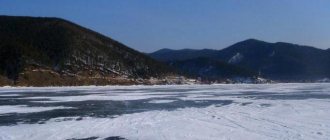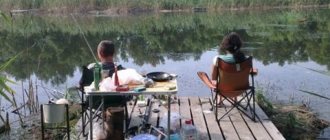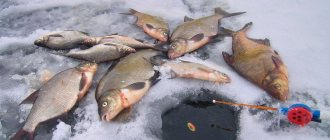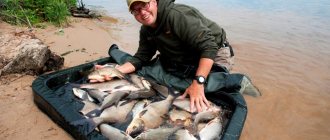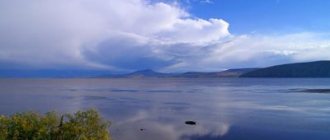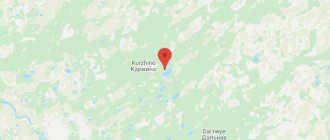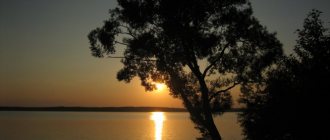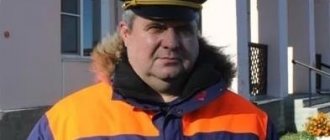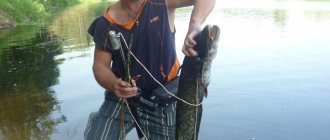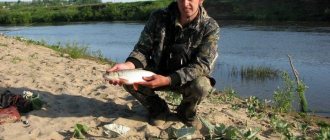The Pskov region, and the city of Pskov itself, is simply an ideal place for lovers of fishing and other active recreation. The presence of a large number of small lakes, as well as two water giants, predispose the area for excellent fishing.
A wide variety of fish attracts fishing enthusiasts using a float rod, feeder or spinning rod. This is truly a unique region, because there are places for fishing for absolutely everyone, from an experienced fisherman to a beginner.
What kind of fish is found in Pskov
The underwater world of the region is so diverse, which has been surprising local and visiting fishermen for several years. In local reservoirs you can find both fish that are familiar to many and quite rare specimens.
What is surprising is the fact that the usual fish species in this area grow to stunning sizes. Still, Taiga makes herself known. I think this is only a positive feature for most fishermen. The most common is:
- Bream;
- vendace;
- Perch;
- Whitefish;
- Zander;
- Pike;
- Burbot;
- Roach;
- Smelt;
- Rudd;
- Tench;
- Ide;
- Shchepovka;
- Loach;
- Loach.

And this is not a complete list of all the fish that live in local reservoirs. And he is already quite impressive, well, at least he surprised me greatly. I'm not used to seeing whitefish, woodchuck and char in the same body of water. What do you think?
National parks and reserves
The uniqueness of each region lies in its unique nature. In corners that are found only here and now. And so that they meet in the distant future, our descendants today are creating national parks and reserves designed to protect and preserve this beauty.
Sebezhsky National Park
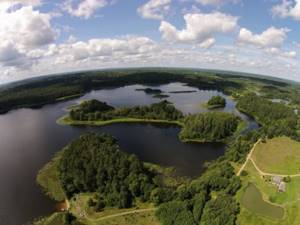
- Coordinates: 56.266667, 28.500000.
The national park in Sebezhsky district is the youngest in Russia. The date of its formation is January 8, 1996. Despite its very modest size compared to other parks, it is distinguished by its rather rich nature and diversity of flora and fauna.
If we talk about Sebezhsky Park in a nutshell, then it can be called a real lake district. In addition to Lake Sebezh, which is the largest, there are also lakes Necheritsa, Osyno and Orono. They are home to a wide variety of fish, and if you are lucky, you can see huge catfish. Plants growing in the park are mostly rare and are listed in the Red Book. The animal world is also amazing. There are about 200 species of birds alone.
Sebezhsky Park can offer tourists not only nature, but also walks through historical places. There is absolutely everything here: archaeological sites, ancient sites, ancient settlements and burial mounds.
Polistovsky Reserve

- Coordinates: 57.170833, 30.556944.
After the retreat of the Valdai Glacier, which occurred about 10 thousand years ago, Polistovye was formed - an amazing wild water region. Here, raised bogs, lakes and rivers flowing into them form a single, interacting system.
To get acquainted with the amazing landscapes, visitors are invited to take one of three eco-trails: visit Lake Polisto or the Moss Moss Path and the Plavnitskoe swamp. For little tourists there is also an excursion dedicated to aquatic diversity.
Pskov Arboretum
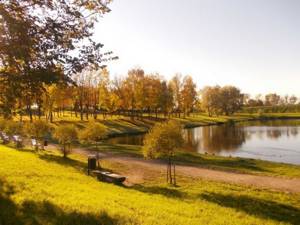
- Address: Yubileinaya street, Pskov.
Where the Mirozha River flows into the Velikaya River, a park appeared a little more than half a century ago. Residents of Pskov planted the first trees and happily forgot about it. Until 2013. During this time, without proper care, it fell into disrepair. But, through joint efforts, specialists from Latvia, Estonia and Russia returned it to its blooming appearance.
Today's arboretum is one of the most visited places in Pskov. This is not only a green area where rare plants for this part of Russia grow, such as wild sycamore and mountain pines, Tatarian maple and wrinkled rose, but also walking paths, recreation areas equipped with comfortable benches, and a pond with a small artificial island.
Remdovsky reserve
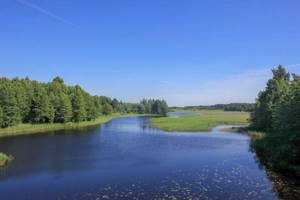
- Coordinates: 58.250000, 27.666667.
The Pskov-Chudskaya lakeside lowland is of international importance as a wetland reserve. This is the habitat of black storks and white-tailed eagles, valuable medicinal plants, and endangered species of wild animals.
For their protection and preservation, it was decided to create a reserve here. On the territory of the Remdovsky reserve there are also unique cranberry swamps, which are natural monuments and the islands on which the Battle of the Ice took place.
Map of fishing spots
The huge Pskov Lake is located in the southern part of the region. Its area is an impressive 709 km². True, the depth is not very great, from 2 to 5 meters, sometimes it is possible to find holes up to 10 meters, but this is very rare. The huge number of fish of different sizes attracts fishermen from all over the country. The treasured catch of everyone in this lake is large bream, pike, pike perch and perch.
Lake Peipsi borders on Lake Peipsi and is separated by the small Lake Tyoploe. Part of the lake is in Russia, and part in Estonia. The area of the reservoir is also quite impressive and amounts to 2613 km². The average depth of the reservoir is about 8 meters, and the deepest hole is 16.5. Many rivers and streams flow into the lake, but only one small river flows out. Ichthyologists count about 40 species of fish in the lake, but fishing enthusiasts prefer burbot, roach, vendace, bream, perch and whitefish.
On the territory of the Dedovichi district there is a small lake Ivankovskoye, which is known in narrow fishing circles. The reservoir is quite shallow, the average depth is only about 3 meters, but local fishermen can suggest a place with deep holes up to 10 meters. There are a lot of crucian carp, ruffe, bream, roach and other fish in the lake. White species of peaceful fish, which are caught on a float and feeder, are especially common.
Gorodnovskoye is one of the small lakes in the Dedovichi district, which, like the previous one, pleases fishermen. True, it is a little deeper and the average depth is about 5 meters. If you are going to catch trophy fish, then it is better to look for holes, they are here and reach depths of up to 11 meters. There are a lot of fish, very different, from bream to spined lance.
Interesting rivers and lakes in the Pskov region
“Water, water... There is water all around...” These lines can rightly be attributed to the Pskov region. More than 10% of the territory is occupied by swamps alone, but there are also rivers and lakes, of which there are about 3,000. Perhaps this region can actually be called a water kingdom.
Lake Peipsi
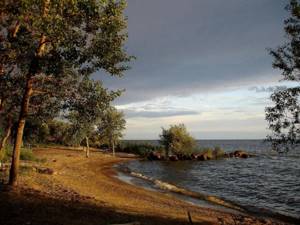
- Coordinates: 58.641729, 27.623851.
The reservoir in the Gdovsky district of the Pskov region is known even to children - it was here that the battle of Alexander Nevsky’s troops with the German crusaders took place. And if you also remember the geography, then it is one of the largest lakes in Europe, second only to Lake Onega, Lake Ladoga and the Swedish Lake Vänern. Geographically, it is located in two states - Estonia and Russia, serving as a dividing line between them.
Despite the fact that the scale of the lake is amazing (it could well be called a sea), its depth is not that great, only 7-17 m.
Because of this, the water here is always warm, which helps attract vacationers and fishermen - Lake Peipus is considered the most fishy in this part of Russia. The shores of the lake are sandy, with ancient boulders scattered here and there. These stones are quite impressive in size and can be found both on land and in water. In general, the coast is filled with the same serenity and tranquility that are inherent in the Russian north-west.
Great River
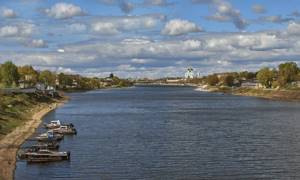
- Coordinates: 57.094989, 28.828833.
The river on which the region's capital, the city of Pskov, stands, actually deserves to be called Great. It begins near Lake Bolshoi Elm and carries its waters across the entire western Pskov region. There are many lakes on the way to this attraction, but it flows into Chudskoye.
At all times, its shores have attracted people. Thanks to good climatic conditions, the proximity of forests and the abundance of fish in the river, they settled nearby. The first to come to Velikaya were the ancient Balts, who over time mixed with the Slavic tribes. We know them as Krivichi. Later, the Letts came here, who, together with the Slavs, began to build cities and fortresses.
The shores of the Great River remember princes, fires and wars, the construction of Pskov. Its waves have absorbed many secrets and mysteries of history. It still plays a big role in the development of the region today. The list of its attractions includes natural monuments, religious shrines, and museums.
Pskov Lake
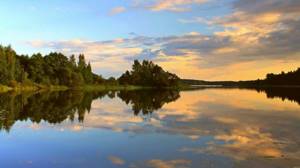
- Coordinates: 58.023831, 27.913144.
It is a paradise for lovers of wild recreation and pristine nature. There are completely quiet, calm places, sandy beaches and shallow waters. Nearby there is a forest area rich in mushrooms and berries, so you can combine business with pleasure on vacation. Even though boarding houses and recreation centers have recently begun to open near the lake, it is still cozy here.
Officially, the reservoir is part of the Pskov-Peipus lake complex, but unlike the border Lake Peipus, it is entirely located in Russia. Its main attraction is the small islands.
People even live on some of them, and on the island of Zalita there is an ancient temple of St. Nicholas the Wonderworker, the date of construction of which is considered to be 1585. Archpriest Nikolai Guryanov, famous for his gift of finding missing people, is buried here, in the local cemetery. Until now, pilgrims specially come to the island to visit the grave of the great elder.
Lake Ale
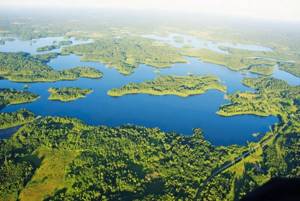
- Coordinates: 56.851549, 29.511175.
There are about 500 lakes on the Bezhanitskaya Upland, but the largest of them is Alyo. Its name comes from one of the ancient Russian words and is translated as “drinking water.” In fact, the water of this lake is crystal clear, which even confirms the presence of crayfish in it. After all, it is known that these arthropods live only in clean running water.
There is also a lot of fish here, and a wide variety of them. Not only residents of Russia, but also the Baltic states come here to fish.
Although swimming is prohibited here due to the heavily silted bottom, it is worth a visit. At least to admire the unique landscapes, the likes of which cannot be found anywhere else. Deep reaches, bays, bays and a mass of islands covered with lush vegetation. And nearby rises Mount Lobno, the highest point in the Pskov region.
Lovat River
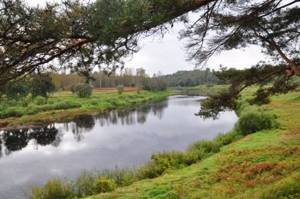
- Coordinates: 56.926519, 30.698846.
This is one of the calmest rivers in the Pskov region. In ancient times, it was part of the trade route from Scandinavia to Byzantium. And today on its banks you can find many archaeological monuments. Back in the 19th century, Lovat was navigable, but now it is popular among lovers of water tourism and rafting.
Lake Beloguli
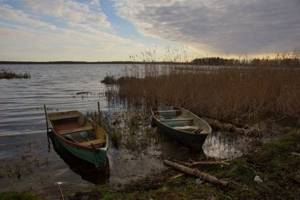
- Coordinates: 57.075669, 29.044995.
A beautiful and picturesque lake with an unusual name is located just five kilometers from Mikhailovskoye. It is located in a valley and is surrounded on one side by forest. But from the other you can see a mountain standing on an island in the middle of the lake. Locals call it the Town and tell a beautiful legend.
There was once a village at the foot of the mountain. Its inhabitants wanted to build a beautiful temple at the very top, and they succeeded. But one fine day, unchrist robbers attacked the village. While the men repulsed the enemy, women with small children and old people took refuge behind the temple gates. And when the robbers noticed the fugitives, they set off in pursuit. But as soon as one of them touched the doors of the temple, he went underground. Only a snow-white dove soared into the sky. Since then, the lake has had such a beautiful name - Beloguli.
In the place where the church used to stand, a flat area formed. They say that if you lie on the ground and put your ear to it, you can hear church singing. People also believe that the time will come and the temple will rise to the surface again.
Lake Gorokhovoe

- Coordinates: 57.276198, 28.357352.
If you want peace and quiet, you can go to Gorokhovoe Lake in the Ostrovsky district. Despite the fact that a children's sanatorium and a biathlon base are located on its shore, the place is considered wild and deserted. It is not too big, about 3 square meters. km, but perfect for swimming and fishing. True, it is best to choose places closer to inhabited areas. The shore there is not so overgrown and the bottom is smoother and sandier.
Free fishing spots in Pskov
Not far from the previous lakes, in the same area, Lake Uzskoye is located. The area of the reservoir is relatively small, which cannot be said about the underwater inhabitants. The depth of the lake is about 5 meters. And a wide variety of fish are caught there, both large bream and trophy pike or perch.
There are a lot of lakes in the Dedovichi district, one of which is called Lokno. The average depth of the reservoir is about 6 meters, but holes up to 12 are often found. There are a lot of fish here, both peaceful and predatory. So, armed with the necessary gear, you can safely go fishing.
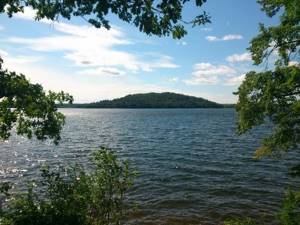
Lake Lokno
The deep lake with an average depth of 14 meters attracts fishing enthusiasts from the entire Pskov region. Many people go on boats to catch bleak, rudd and trophy silver bream. But fans of fishing for predatory fish also often come for large pike and perch.
Myachkovskoye Lake is also located next to the previous ones, and is also famous for fishing. The average depth of 5.5 meters and the presence of five islands in the middle of the reservoir make it a promising place for fishing. In the lake you can catch different fish, both peaceful and predatory.
Lake Naverezhskoye is also located in the Dedovichi district. True, its average depth is only about 3.5 meters and there are only 3 islands. But such conditions suit pike, roach, crucian carp, bream and loach. Armed with a float rod, you can safely go there in search of large fish.
Pskov region: sights from time immemorial
From the very beginning, the Pskov region was associated with great people who left their mark on the history of mankind. Princess Olga and Vladimir Monomakh, Truvor and Alexander Nevsky, Pushkin and Mussorgsky... These names alone are enough to become interested in her history.
Porkhov Kremlin
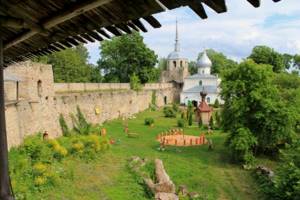
- Address: ave. October 25th, Porkhov.
The Porkhov town on the right bank of the Shelon River was founded by Alexander Nevsky himself. True, the Grand Duke at that time had not yet received his nickname. The city was supposed to become one of the checkpoints strengthening the waterway from Novgorod to Pskov. Already 100 years after its foundation, in 1346, the Porkhov fortress - one of the few - withstood the siege of the Lithuanian prince Olgerd.
Today it is located in ]the city of Porkhov[/anchor]. The appearance of the fortress has remained almost pristine, so today it is possible to see the ancient ramparts with log walls laid on top of them. Inside the Kremlin there is the ancient St. Nicholas Church built in 1412 and several museums, including a local history museum.
Truvorovo settlement
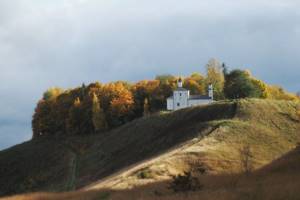
- Coordinates on the map: 57.716991, 27.853701.
Modern Izborsk on Zheravya Mountain was built only in the 14th century, and initially occupied only a triangular cape above Lake Gorodishchenskoye. Its history is inextricably linked with the name of Truvor, one of Rurik’s brothers, who ruled Izborsk until 864. After the fortress was moved, the former settlement remained in a neglected state.
Only at the end of the 14th century was a cross erected here, which is now known as Truvorov. Today, on the territory of the settlement there is an ancient cemetery and the ancient church of St. Nicholas the Pleasant. Since the beginning of the 70s. Archaeological excavations have been carried out here since the last century.
Chernitsa Fortress
- Coordinates: 56.567222, 28.775000.
The fortress was built on the border with the Principality of Lithuania as a stronghold and was considered one of the most ancient in the Pskov region. Mentions of it can be found in the List of Russian cities near and far.
Unfortunately, the fortress has not survived to this day. It was destroyed in one of the Russian-Polish wars by the troops of Stefan Batory. For a long time, the Chernitsky churchyard was located on the territory of Chernitsa, which later became part of the village of Aleksino. Today this fortress, along with many, is considered forgotten.
Town on Lovat
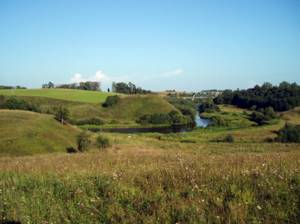
- Coordinates: 56.304444, 30.474722.
The historical and archeological monument of the 10th century is located just 3 km from the city of Velikiye Luki, in the Gorodok tract. At one time it was one of the largest trade and craft centers on the way from the Varangians to the Greeks. Today it is one of the most excavated and studied ancient settlements in the Pskov region.
Location of Lake Peipsi
Lake Peipsi is located on the territory of two countries: the eastern shore belongs to the Russian Federation, the western and back shore belongs to the Republic of Estonia, where it is called Peipsi. The reservoir is part of the Chudsko-Pskov lake complex. Coordinates of the object on the map: latitude – 58°38′16″, longitude – 27°30′12″.
In summer and winter, the lake attracts fans of fishing; common prey is:
- mirror carp;
- ruff;
- pike;
- perch;
- zander.
On the coast of the lake there are tourist bases (the most popular are “Chudskoye Podvorye”, “Prichudye”, “Far Away Kingdom”), clean water and a sandy bottom attract tourists who prefer a relaxing holiday.
Main attractions of the region:
- Cathedral of the Icon of the Sovereign Mother of God;
- Gdov Fortress;
- Museum "Samolvovo Barn";
- Church of St. Trinity, Peter and Paul, St. Nicholas.
Route options:
1. From St. Petersburg (direction – the city of Gdov):
- by car, driving along the E20, E360 highways, distance – 250 km, travel time – 4 hours;
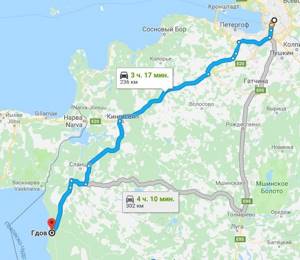
- by bus from the Obvodny bus station, trip duration – 4 hours 30 minutes;
- by train “St. Petersburg-Gdov”, departing from the Baltic station, travel time is 4 hours.
2. From Moscow to Pskov by train, departing daily from Leningradsky Station (journey duration - 5 hours), then to your destination by public transport or taxi (1 hour drive).
3. From Tallinn to the city of Tartu (distance - 200 km), then by bus to the port of Laiksaare (150 km). The average travel time is 5 hours.
General information about Pskov Lake
Lake Pskov is one of the most mysterious bodies of water in European Russia. It was an eyewitness to many historical events and bears the imprint of ancient times.
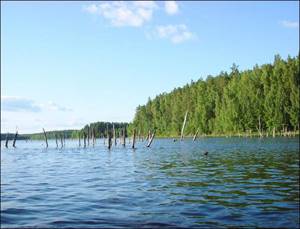
Where is Lake Pskovskoye located? This body of water separates Estonia from Russia from the Leningrad and Pskov regions and is part of the Baltic Sea.
This reservoir consists of several parts: Chudskoye (in the north), Pskovskoye (southern) and Teploe (located between the previous two) lakes.
More than 25 rivers flow into Lake Pskov, but only one flows out.
Lake Peipus: description, photo, video
One of the largest lakes is Lake Peipsi. It is located on the one hand in Russia, and on the other in Estonia. The depth reaches 16 meters, and the area is almost 3000 km2. In terms of the amount of fresh water, it is inferior to Lake Baikal. There are many islands in the lake’s waters, from which it is convenient to fish at any time of the year. The magnificent nature and excellent fishing in the surrounding area attracts tourists.

Pskovsko-Chudskoye Lake
Local residents call the lake Pskovsko-Chudsky. Many nearby rivers flow into it, making it flowing. Beautiful nature, a nature reserve, and picturesque places are conducive to relaxation. There are recreation centers in the coastal zone. In good weather, long excursions around the lake by boat are organized.
On the Estonian side the lake is deepest. There are many people who want to admire the beauty of one of the largest lakes in Europe. There is a lot of entertainment for relaxation - swimming, boating, beach sports, fishing. Tourists are offered various conditions from luxury villas to romantic campsites, for every taste.
Panorama of Lake Peipsi
Lake Peipus is known for its legendary status. In 1242, the Battle of the Ice took place there. Prince Nevsky, having gathered troops from Novgorod and Vladimir, defeated the German knights of the Teutonic Order. Before this, the Prince’s troops defeated the Teutonic base in the adjacent territory of the lake. Thus, Pskov was liberated and the Germans prevented the capture of Veliky Novgorod and Vladimir.
Active recreation on Pskov Lake
Pskov Lake can also be considered an excellent place for active pastime. Rest in this case can be organized a little differently. Rent fishing equipment and a boat and go fishing in the wilderness. The catch in a given area depends not only on the season, but also on your fishing skills. And if you are new to this business, experienced instructors will teach you the craft, and you will undoubtedly catch the biggest carp or bream.
Fishing on Lake Pskov is in increasing demand every year. Lovers of active recreation come to this area from all the cities of Pskov, Leningrad, and other nearby regions.
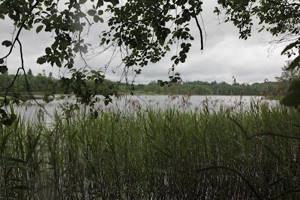
In addition to fishing, on the coast of Lake Pskov you can go cycling, ride a yacht, motor boats, water ski, play football, paintball, volleyball and other games.
Intriguing and mysterious places
Strange places and natural anomalies are everywhere. In any city in Russia, local residents can pass on several mysterious stories from generation to generation. The Pskov region is no exception. Where else if not here would miracles happen and alien inhabitants land.
Dukhova Mountain

- Coordinates: 56.748774, 28.554856.
A strange and even scary place is located in the Opochetsky district, not far from the village of Kirovo. The mountain, more like a burial mound, attracts attention not only with its unusualness, but also with some kind of magnetism.
At its top there is a church and a cemetery, and you can also see strangely curved trees. These are found only in places of great power, as evidenced by the compass needle, or the equipment that stops working at the top of Spiritual Mountain. Even metal cemetery crosses begin to bend over time, and during a thunderstorm, lightning always strikes the top.
Despite this, the flow of pilgrims to the mountain does not dry up, considering this place sacred. But there is a belief that you can only come here with a pure soul and thoughts, otherwise the mountain will not let you approach it or will severely punish you.
Bychiy Ruchey tract
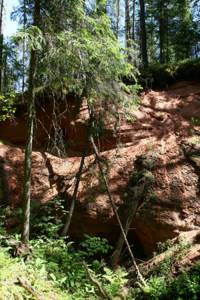
- Coordinates: 58.634520, 28.505493.
A very beautiful and mysterious place. To be more precise, a suffusion cavity is the name given to the failure of soil above an underground stream. It is quite large, about 30 m in diameter and 3-4 m deep. Getting to it is not easy; the road goes through a wild forest.
But for those who are lucky, an amazing sight opens up: many grottoes of the most bizarre shape, carved by water. If you look around well, you can see the source of the stream. Travelers note that there is a very light and pleasant energy here, but for the wilds of the forest the place, of course, looks alien.
Sludy on the Plussa River
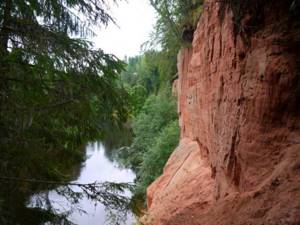
- Address: Plyussky district.
There are no places like this anywhere else in the Pskov region. The word Sludy in this area refers to a steep bank. And indeed, amazing cliffs of red-rusty sandstone appear before your eyes.
In some places you can see small recesses-caves. These are traces left by sources that have long since dried up. Although there are some that have survived. Crystal waterfalls flow from caves with springs, falling straight into Plyusna.
Damn ravine
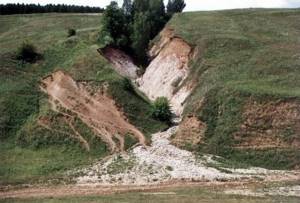
- Address: Lyady village.
This place is also called the Lyady Triangle, from the village of Lyady, not far from which it is located. Here, according to rumors, people constantly disappear. There is even talk of a temporary failure.
Mystical disappearances occurred here even before the revolution and continued after it. If we think logically, then they can be fully explained. The ravine itself is a remote place; the sun practically does not penetrate here, as do sounds. And those that are audible are very distorted. Therefore, it is very easy to get lost here.
But if there were people, then there should be at least some traces of their presence. And this, precisely, was not found in Devil’s Ravine. That's why he gets a bad reputation.
Trutnevskaya cave

- Coordinates: 58.615000, 27.949444.
In the Gdov region on the Kunest River you can visit another natural and historical monument. This is a sacred cave with unique trace stones. She is one of the most revered in the Pskov region.
Once upon a time they wanted to put a mill on this place. But when construction began the next morning, it was found destroyed. This went on several times until the workers decided to trace who was doing it. The whole night passed calmly, and only in the morning they were awakened by a terrible roar. The mill was again destroyed, and the Virgin Mary walked along the river, leading the baby by the hand.
After a few steps, she disappeared, and in that place people saw a small cave with stones, on which depressions in the form of human footprints were found. One of them was large and several more were smaller. The old people decided that it was impossible to install a mill here, and an altar was installed in the cave.
There are many springs near it, but believers try to get water from the footprints. It is considered not only useful, but also healing. According to tradition, a religious procession takes place here on the sixth Friday after Easter. It was on this day that a miraculous phenomenon occurred.
Flora and fauna
The vegetation of Lake Pskov is rich and varied. Along the banks of the reservoir, reeds and reeds grow to a greater extent. In those places where rocks protect from the winds, you can find such vegetation as water manna, broad-leaved grazing grass, common grass, calamus, narrow-leaved cattail, fescue reed, silty horsetail and some others.
As for those plants that develop directly on water, they are extremely rare here. As a rule, these include amphibian buckwheat and arrowhead.
In the Baltic region you can hand-feed birds (ducks and swans), and admire the springs flying in the sky in autumn and spring.
Those who are interested in fishing on Lake Pskov can prepare gear for catching perch, bream, roach, pike perch and so on.
